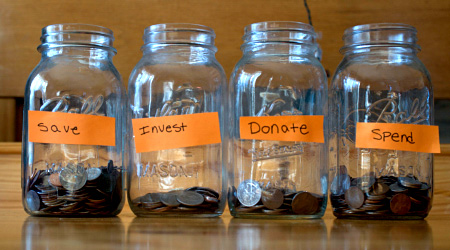How To Budget An Allowance

Parents raising young children do them a disservice if they don't teach them early about money by explaining where it comes from and how best to use it. Budgeting an allowance is part of general financial education and it should start early because if a parent waits until junior high school it will be too late. Financial responsibility and understanding the role of money in society for achieving goals is as important, if not more so, than most other aspects of education. Explaining to your child how to earn money, save that money and spend their money wisely will serve them long after they've left home.
Earn It
Why would a child need to learn how to budget an allowance? They need to understand how someone earns money and how they should prioritize its use. Earning an allowance creates a solid foundation in understanding the concept of work for pay. Money is not limitless or magically shows up out of thin air to allow them to purchase toys and candy. Money is something that is earned. Either once a week or once a month, after work is performed satisfactorily, pay will be received and that will be it until the following week or month. This is essential for budgeting as it establishes the concept of limited financial resources which then leads to prioritization of goals.
Save It
Once a child has received payment for services rendered such as chores, extra care should be used to explain how to prioritize these newly available funds. Prioritization of goals is a key aspect of budgeting an allowance in that it establishes guidelines for both short-term and long-term rewards as well as a rainy day fund. Are these concepts to advanced for young children? No, not really. As any parent knows, children can be incredibly intelligent but the discussion must be focused on them and their goals. When explaining savings, put it into terms which they understand. Mention that if they save most of their allowance for the next four weeks then they will be able to buy something bigger and better. Instill in them a desire to save for the future rewards as they become available.
Spend It
The final aspect of explaining to children how to budget an allowance is in spending their money wisely. At this point they understand how they get money, by working for it, and they understand that saving money is a good thing with multiple benefits. Now they need to learn how to spend their allowance to yield the most benefit. Again, frame spending their allowance as something that, if they do correctly, they get more of what they want. Comparative pricing, sales and coupons are all part of spending education. Teach them that patience is a virtue and smart people get the most from their hard work. Maybe they want a tennis racket so help them go to garage sales and look online. Maybe they're looking at a favorite toy so show them how to comparison shop. If they want a video game or a toy, show them how store coupons during the holidays can save them more money. The last thing a child should do is save their allowance for six months and then pay too much for something they want.
Conclusion
Teaching children how to budget an allowance is a multistage process and at each point it should feel like a reward. People only do what directly benefits them so explaining to a child how earning, saving and spending, if done wisely, can be beneficial since it instills a sense of ownership and independence. These concepts are important to establish early because as soon as they get their first part-time job, the worst thing that can happen is they get their paycheck and immediately waste it. Understanding money is just as important as driving safely and doing well in school. At the time it may not seem particularly important but these are life lessons which will determine a person's health and security far into the future.
Elsewhere on StockMonkeys.com







